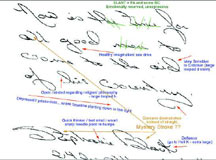Sensitive
to criticism.. big d loop.
Defiance
- capital K
Big
imagination / sex drive
Depression
- downward slanted baseline
Big
ego - Nice sized capital letters.
Domineering
- t-bars slanting down to the right
Variable
MOOD - a combination of FA and BC slants. Indicates her withdrawn
logical repressed persona is unpredictable and offset by a more friendly
BC slant on occasion. You can only notice the BC slant if you measure
it properly using the emotional guage.
Also,
inmy experience, most FA writers with slants that go that far to the
left have some form of percieved abuse in childhood which resulted
in a need to emotinally withdraw from the world. Even though the "situation"
may not be current, the defense mechanism of withdrawl is still active.
LARGE
WRITING in general indicates someone who has good social skills and
can be friendly. ( A bit of a paradox here: friendly, but emotionally
reserved. So, she will talk about you... but keep her feelings to
herself. )
Funky
y-loop: indicates an incomplete sex drive with issues from the past.
This girl has some MAJOR unresolved issues from her past.
If you
want to learn more, checkout the new Certification
Course or get the Change
Your Life in 30 Days workbook for Adults or Kids.

MYSTERY
TRAIT
Finally,
a MYSTERY TRAIT. This strange concave downstroke in the letter "t"
in Stephanie... what does it mean?
Here
are emails from a few people with opinion
The
general interpretation for concave lower zone
strokes is: "The writer is insecure and discouraged,
defensive and self-protective ... He may avoid sexual
behavior due to fear, uncertainty or inhibitions." *
There's also a more specific trait called "lower zone
sickle-like" -- that points out to negative
characteristics, such as aggressiveness and resentment.
My personal opinion is that the trait you,ve asked for
in the writing of S. Black corroborates the
introverted and defensive nature of the writer, and
also tells me that there's some anxiety regarding her
relationships, all of which is stressing her.
Hope this helps.
Victor K.
kame_7@yahoo.com
* Erika M. Karohs. "Handwriting Analysts' Companion."
Volume 2. Self published, 1999.
********
From:
Jaxom Vladimir <arcadio27@yahoo.com>
Subject: Mystery Stroke
To: mail@myhandwriting.com
The concave downstroke, does it mean Stephanie is
pregnant or wants to be? I am only guessing this, but
she does have the large lower 'g' loops, and is very
social. It seems to be a logical guess to me.
Thanks,
Jason
Craft - arcadio27@yahoo.com
****************************************
From:
Anita
Subject: STEPHANIE BLACK'S H/W
Stephanie is most assuredly an introvert, even if she does operate
in extroverted capacities. Why an introvert? Look at her usage of
space: wide spaces between the words, wide spaces between the lines,
disconnections between the letters -- all in all, a visually "airy"
picture of space. Extroverted capacities? Overly large and wide
capitals, wide expansion between letters. Stephanie has a tremendous
amount of psychic energy, which flows inward rather than outward,
backwards rather than forward -- Back to the Future. The h/w is
left trend (to the past) with backhand slant, back strokes, some
of which attempt to redirect to the right (future) but cannot go
the distance. Look at the f, in "for" (line1); the y,
in "country" (line 4). The extreme backhand slant would
indicate Stephanie's preoccupation with the past;i.e., mother influences
and her rejection of authority; i.e. male/father influences (no
right trend). Her emotional development is stuck in early adolescent
rebellion issues (don't know her current age), which she is still
fiercely protecting.
Now for the MYSTERY STROKE: What you see in Stephanie's l's, (look
at "all" in line 2 and "Black" in her signature),
as well as the t, in "Stephanie," is referred to as DIRECTIONAL
PRESSURE. The letters bend in concave fashion; i.e., hollow from
the left (the past), bulging out to the right (the future). This
is an AVOIDANCE stance. Imagine yourself standing erect in front
of someone who puts a knife or gun to your back. You have an automatic
reflex, which bends your body into an avoidance posture. Stephanie
has taken such a posture, because even in her zeal to cling to the
past -- she is extremely anxious and fearful about it. This is a
major conflict, one which prevents her from emotionally standing
upright! There is really no comfort to be derived from this. Yet,
as Stephanie's self-esteem is really low (overly large, grandiose
capitals, small middle zone); and, because she's a pretty defensive
gal (lower loops and backstrokes) and inhibited (cover strokes in
MZ and LZ ("p" in signature), despite her showy presentation
she is experiencing a kind of hysteria from not being able to get
her incredible energy moving outward. Looking at the downslant of
the text, as well as her signature, Stephanie could be experiencing
some depression, which comes with the anxiety territory described
above.
Regards,
Anita Beckenstein
tribecka@cmix.com
******
X-Sender:
"R&K Connelly" <rcandkc@pop.flash.net> (Unverified)
To: newsletter@myhandwriting.com
Subject: Concave Downstroke
Since I have absolutely no clue as to what this means, this is a
total shot in the dark. If it was a concave 'T' bar it would mean
self-control, so couldn't it still have something to do with self-control?
She floats from FA to BC, maybe she is attempting to curb her outwardness
and maintain her FA writing. She may feel she has to stay as emotionally
inexpressive as possible and this shows the stress she is going
through to hold back.
Again, I could be way off here, but what the hell, I could be dead
on.
********
Hi,
Concave downstrokes: warped imagination, twisted, not clear, confused.
Tony DeSerpa
deserpa@mediaone.net
********
Dear Mr. Baggett,
You
have taken a question about the meaning of the concave downstroke.
My suggestion is that it means the writer is nervous and has some
spinal problem. She is influenced by the past, mother, and he/she
is egoist. Everyday mystery is on the left, spiritual mystery is
on the top side, so this stroke pulls down into the person,s everyday
life -- this feeling. It can be very difficult to get close to him/her.
I hope you like my answer. Sorry for my mistakes, but I am not English.
Best
regards:
Kalman Toth - defenceyow@comnet.ca
****
Bart's thoughts...
I
think they are all very creative and well thought out answers. Because
it is soooo unusual, I don't claim to have the answer. I actually
can't say any one is dead wrong. But, if push comes to shove, I
would tend to side with Anita Beckenstein
and Victor on the meaning of the concave mystery stroke.
Her interpretation works well when you take the rest of the writing
into consideration.
The
only part of Anita's analysis I don't completely agree with is her
statement that says Steph has a low self-esteem because of the big
capital in her name and small middle zone. I will agree she has
many insecurities and they will get bundled as self-esteem issues,
but in my experience a large capital boost the ego (not self-esteem,
just ego) and the size of the middle zone will relate to her social
appetite, not her esteem. Her t-bars are generally crosses above
average, so I will weigh in on the "practical " to average
self-esteem with many, many issues relating to trust, intimacy,
fear of criticism, etc. It all get thrown in together, doesn't it?
Good
job Anita and Victor.
******
Other
thoughts..... The strange stroke in "y" in country,
Hi Bart,
Here
are my thoughts on Stephanie Black,s writing. The strange stroke
in "y" in country, I believe is a variation of the teenage
"y." The stroke comes down, swings to the left or the
past to gain some insight from what she was taught before, then
the stroke swings back to the future, with a little hook on the
end. It's tenacity in the physical zone. I see it in the middle
zone also. So, whatever it is that she has, she does not want to
let go of it. As for the t, and l, strokes in her name, to me it
looks consistent with her style of writing, though unusual -- it
is consistent. This strange bending of downstrokes does not happen
in every downstroke letter. So, why in some t's, and the l's, in
"all"? It has that same look of going into the past, then
swoosh, into the future until the next letter is made. Obviously,
I could make the general statement that there's something in her
past that she's trying to deal with, but keeps going back and forth
on it. My source is Bart Baggett and the Deluxe Home Study Course.
Tracy
Wilson - analyzeme@home.com
P.S..
Special thanks to Stephanie for allowing us to analyze her.
Want
to discuss this trait or talk to other handwriting students? Visit
our worldwide
bulletin board... it's free.


